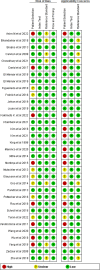Shock index as predictor of massive transfusion and mortality in patients with trauma: a systematic review and meta-analysis
- PMID: 36872322
- PMCID: PMC9985849
- DOI: 10.1186/s13054-023-04386-w
Shock index as predictor of massive transfusion and mortality in patients with trauma: a systematic review and meta-analysis
Abstract
Background: Management of bleeding trauma patients is still a difficult challenge. Massive transfusion (MT) requires resources to ensure the safety and timely delivery of blood products. Early prediction of MT need may be useful to shorten the time process of blood product preparation. The primary aim of this study was to assess the accuracy of shock index to predict the need for MT in adult patients with trauma. For the same population, we also assessed the accuracy of SI to predict mortality.
Methods: This systematic review and meta-analysis was performed in accordance with the PRISMA guidelines. We performed a systematic search on MEDLINE, Scopus, and Web of Science from inception to March 2022. Studies were included if they reported MT or mortality with SI recorded at arrival in the field or the emergency department. The risk of bias was assessed using the QUADAS-2.
Results: Thirty-five studies were included in the systematic review and meta-analysis, for a total of 670,728 patients. For MT the overall sensibility was 0.68 [0.57; 0.76], the overall specificity was 0.84 [0.79; 0.88] and the AUC was 0.85 [0.81; 0.88]. Positive and Negative Likelihood Ratio (LR+; LR-) were 4.24 [3.18-5.65] and 0.39 [0.29-0.52], respectively. For mortality the overall sensibility was 0.358 [0.238; 0.498] the overall specificity 0.742 [0.656; 0.813] and the AUC 0.553 (confidence region for sensitivity given specificity: [0.4014; 0.6759]; confidence region for specificity given sensitivity: [0.4799; 0.6332]). LR+ and LR- were 1.39 [1.36-1.42] and 0.87 [0.85-0.89], respectively.
Conclusions: Our study demonstrated that SI may have a limited role as the sole tool to predict the need for MT in adult trauma patients. SI is not accurate to predict mortality but may have a role to identify patients with a low risk of mortality.
Keywords: Hemorrhagic shock; Massive transfusion; Mortality; Shock index; Trauma.
© 2023. The Author(s).
Conflict of interest statement
The authors declare that they have no competing interests.
Figures
References
-
- World Health Organization. Injuries and violence [Internet]. 2021 [cited 2023 Feb 11]. Available from: https://www.who.int/news-room/fact-sheets/detail/injuries-and-violence
-
- Holcomb JB, Del Junco DJ, Fox EE, Wade CE, Cohen MJ, Schreiber MA, et al. The prospective, observational, multicenter, major trauma transfusion (PROMMTT) study: comparative effectiveness of a time-varying treatment with competing risks. JAMA Surg. 2013;148:127–136. doi: 10.1001/2013.jamasurg.387. - DOI - PMC - PubMed
Publication types
MeSH terms
LinkOut - more resources
Full Text Sources
Medical






